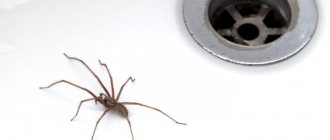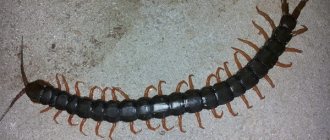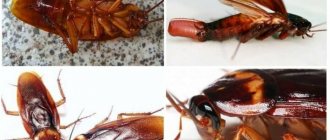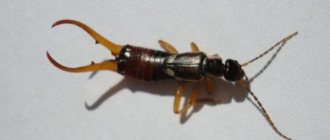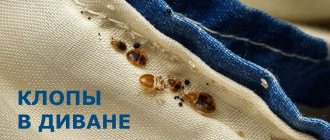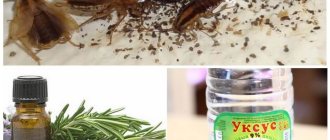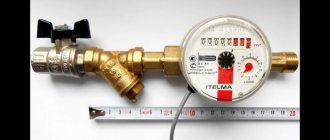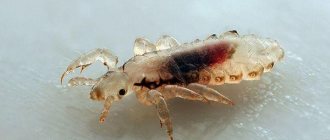In some cases, while taking a shower, you may find an unpleasant gift under your feet - a small, unpleasant-looking creature that looks like a mustachioed beetle.
Often, out of ignorance, these creatures are mistaken for beetles, centipedes, even silverfish (although there is no similarity to the latter in appearance at all). But this is just a common woodlouse (armadillo), an absolutely harmless, but no less unpleasant creature.
Habitat
In nature
Where do woodlice live in their natural environment? In nature, they can live wherever conditions are favorable - there is moisture and there is a large amount of food. Woodlice feed on semi-decomposed organic matter, root crops, vegetables, eat tender leaves of plants, and can eat spoiled cereals and rotten fruits.
In a garden or vegetable garden, they can be found under stones, in secluded damp corners of the garden - near a pond, not far from a well, next to a rain ditch or sewer.
In the wild, small crustaceans choose as their habitat areas near a river or lake , slightly swampy places, natural depressions in stones and soil where moisture accumulates.
In the apartment
Why do these small pests appear in the apartment, especially in the bathroom? To breathe, woodlice need very moist air, so they settle in apartments where the conditions for their life and reproduction are favorable - in bathrooms, kitchens under the sink, air ducts where rainwater penetrates and accumulates.
What does woodlice eat?
This type of crustacean is completely unpretentious in food; its menu includes:
- rotting food scraps;
- plant remains;
- slime on the walls;
- dust.
Woodlice can cause damage to garden plants, but they also eat weeds.
Why do they start?
Why do woodlice, which are often mistakenly considered insects, choose a city apartment as their habitat, why are there many of them in attics and basements, what are the reasons for their appearance in a country house?
In the apartment
Let's look at where woodlice come from in a city apartment. In apartments, small pests most often appear from common areas where sanitation standards are not observed. These are mainly basements of apartment buildings or attics.
In basements, woodlice can live for a very long time and reproduce successfully, since it is damp and contains organic matter for nutrition:
- mold spores;
- mushrooms;
- grass roots;
- rotting vegetables.
In leaky attics, crustaceans can feed on leftover grain from pigeon droppings and rotting wooden floors.
From these habitats, woodlice can move through air ducts or through cracks to the first and last floors where residential apartments are located, and if they find favorable conditions there, they remain to live and reproduce.
Read about why there are woodlice in the bathroom or toilet and how to get rid of them, and find out what woodlice eat in the bathroom, apartment and other rooms here.
In a private house
Pests can be brought into private country houses from the garden , along with vegetables and herbs. But often small crustaceans themselves make their way into damp basements, attracted by the food reserves stored there.
A damp, poorly ventilated basement or leaking attic, rotting wooden structures of the house, never-drying ditches near a summer cottage, and damp sewers are ideal conditions for the survival of woodlice.
Reference . You can bring crustaceans into your home with purchased vegetables or herbs, but in the absence of favorable conditions in your apartment or dacha, they will not take root.
Features of life
Woodlice love high humidity . During the day they hide in shelters: in earthen burrows, under stones and loose bark, in a pile of fallen leaves and in damp rooms.
Land crustaceans are unpretentious when it comes to food . At night they feed on organic debris: rotten wood, rotting vegetation, fungal spores on plants, and when there is a shortage of food, their own excrement. Woodlice themselves are rarely eaten by birds; more often they serve as food for spiders, toads and lizards.
Woodlice live for about a year and breed in April-May, mainly at night. For this purpose, females form a special brood chamber filled with liquid. Fertilized eggs enter it, and offspring subsequently appear there. Young individuals leave the brood compartment already well developed. During the process of maturation, they molt several times.
How to determine where they breed?
First of all, you need to understand that these creatures breed where there is maximum humidity. Therefore, you should look for their habitat in precisely such places - in the bathroom, under the floor in the kitchen near the sink. If possible, you need to inspect the attic and basement .
In country houses, be sure to go down to the basement and look for nests of pests in dark corners, turn over stones and bricks, check the water supply and sewerage for leaks.
It is the infestation of woodlice that often leads to residents discovering a leaking roof or a leaking water supply.
The presence of woodlice in public areas is an alarming signal. The pests themselves can serve as carriers of diseases , but their presence also indicates high dampness in the premises, and this causes the appearance of mold and mildew, which is already very dangerous for the health of residents of the apartment complex. Having discovered woodlice, you should immediately call the housing office and call the sanitary control service to check basements and attics.
If the house has pantries or closets where vegetables are stored, they should also be inspected, lifting sequentially the containers where the supplies are poured.
Woodlouse is a small crustacean whose average size is 10-12 millimeters
However, in some cases larger individuals are found, up to 18 millimeters. The body is gray, in some cases dark almost black, although there are also almost white specimens, the carapace is 7-segmented, slightly plastic, round in shape. Each segment has its own pair of legs (7 pairs of legs in total).
On the small head of the crustacean there are two pairs of antennae (one pair is long, noticeable, and the second is underdeveloped), the eyes are located on the sides. At the end of the body there are tactile organs, similar to 2 small appendage tails.
What are the first signs of entering a home?
Small crustaceans are nocturnal creatures, so their presence in the house can be detected quite late (a description and classification of woodlice can be found in this material). Signs may include:
- spoiled vegetables;
- traces of feces near the trash can and in the kitchen sink area;
- traces of vital activity in cereals or greens.
Also an indirect sign can be dying house plants - wood lice often settle in pots of soil, feeding on the roots and leaves of the flower.
If these moments exist, you need to make sure that these are woodlice. To directly detect crustaceans, you need to examine the dark corners of the bathroom, basement or attic of a residential building at night, illuminating with a flashlight all the corners, crevices and possible cracks in the walls, in basements - lifting objects lying on the ground. It is under bricks, overturned buckets and stacked boards that these pests like to nest.
More about Porcellio scaber
We invite you to familiarize yourself in more detail with the type of woodlice that is found in our apartments. The species Porcellio scaber is a species of European woodlice that is found everywhere, almost anywhere on land on our planet. It is found throughout Central and Western Europe, North America, South Africa, Australia and, of course, in our country. Such a wide distribution of the species occurred mainly due to human activity.
Woodlice can grow up to 20mm long. It is generally gray in color with some shades of purple on its upper dorsal region and paler, almost white, on its lower dorsal region.
Depending on environmental conditions, primarily temperature, brown, blue and even yellow or pinkish shades of woodlice body color may occur. As noted, this species lives in a wide variety of habitats that contain reasonably high levels of humidity, but it is worth noting that it is less dependent on water than other species.
How to get rid of it?
There are many ways to get rid of uninvited guests - from homemade to store-bought. The means you can use are the same as for cockroaches :
- crayons;
- traps;
- poisonous baits.
If there are too many wood lice in the attic or basement, you should call special services that destroy insects.
But all extermination measures will be useless if unbearable conditions are not created for the pests .
Therefore, first of all it is necessary:
- dry the bathroom by installing an additional heater;
- seal cracks in the floor and walls, from where new batches of crustaceans can crawl;
- throw out the trash can on time, without leaving waste overnight;
- check all pipes and taps for damage;
- wipe the floor in the apartment dry, temporarily do not dry clothes in the kitchen and bathroom;
- in a country house, thoroughly ventilate the basement and repair the roof, preventing leaks.
If pests have settled in flower pots, change all the soil, washing the roots of domestic flowers with running water before replanting. This way there will be no crustacean eggs left on them and they will not be able to reproduce again.
Only if these conditions are met will it be possible to get rid of wood lice forever.
There are different types of woodlice and therefore we have prepared materials about the types of this pest, including the white woodlice.
Folk remedies
- Chlorine (solution of 50 ml per 1 liter of water).
- Boric acid (solution of 2 g per 0.5 liters of water).
- A mixture of dry tobacco, soda and red pepper (the ingredients are mixed in the proportion of 100 g of tobacco: 1 packet of pepper: 2 tablespoons of soda per 1 liter of water).
- Dry kvass (solution of 100 g per 1 liter of boiling water).
- Quicklime (place several containers indoors and leave for 3 days; you must leave the house during this time).
Prevention of occurrence
The most important thing to do to prevent pests from appearing is to keep the house clean and dry .
- Avoid leaks or eliminate them in a timely manner, prevent vegetables and fruits from rotting in places where they are stored, regularly ventilate/dry the bathroom, take out the trash in the evening.
- In country houses, it makes sense to dry the basement well in the summer, creating a draft, and regularly check the roof and repair it in a timely manner.
- In summer cottages, you should not store large amounts of organic waste close to the house; it is better to move the compost heap, where wood lice love to nest, to the far corner of the garden.
Thus, woodlice are extremely unpleasant pests that can not only frighten with their appearance, but also cause a lot of harm - spoil supplies, undermine the wooden structures of houses, and transmit diseases. To destroy them and prevent their occurrence, the main condition must be observed - dry air. Without sufficient moisture, woodlice will not be able to breathe and will either die or leave the home forever.
Professional disinfection
To carry out professional removal of wood lice, you must contact the sanitary service, which will treat the premises and eliminate not only the insects, but also their eggs.
Also, many organizations use special barriers that block the appearance of fleas and woodlice for a long time.
Let's celebrate! The room is treated with a special fog, which quickly eliminates infection and parasites and does not harm human health. After disinfection, a person can observe the result of the procedure in a short time.
Saving plants
Woodlice can attack some types of indoor plants. First of all, these are orchids. If rescue measures are not applied, the flower will die in two weeks. The same goes for ferns.
What signs can be used to identify wood lice infestation? The soil in the pot will begin to compact for no apparent reason. Loosen it with a tool and if you see white worms, then that’s it, the flower is infected with woodlice.
It is necessary to loosen the soil of orchids and ferns, otherwise the roots will not receive the required amount of oxygen and will die. Woodlice make the soil dense. Therefore, it is important to take action. To do this, carefully remove the flower from the pot, shake the roots off the ground and wash them in a weak solution of potassium permanganate. After the plant needs to be planted in new soil. It is best to throw away the used pot, as it can attract woodlice.
Catching belt and 3 more ways to protect trees from garden pests
Some general information
Today, there are more than 3,600 species of woodlice, and all of them live throughout the world, both in the aquatic environment and on land. Woodlice are ancient species of crustaceans that evolved from an aquatic environment to the minimum extent that they were able to live on land.
Different species have adapted to a wide variety of habitats, making them difficult to eradicate. Their semi-rigid outer shell provides an effective barrier against most changes in temperature and humidity as a protective layer. However, one thing they cannot cope with is the dryness of their body. Any type of woodlice always needs moisture, otherwise they will simply dry out and die.
The survival and reproduction of these species is related to the ability to feed on a wide and varied diet. They are omnivores.
Woodlice have a digestive system that allows them to feed on objects that poison other types of living organisms. These creatures thrive on animal feces, mold and rotting carcasses, breaking down food scraps and cellulose.
Woodlice have an excellent opportunity to quickly increase their population numbers. In some species, the female lays eggs three times a year, up to approximately fifty eggs each time. The expectant mother keeps the eggs in a special pouch on her body until they open. The offspring begins life at approximately 2 mm in size and at first stays exclusively near the mother.
